University Literature Review: Ethical Risks in Organizational Settings
VerifiedAdded on 2019/10/30
|7
|1403
|237
Literature Review
AI Summary
This literature review explores the multifaceted nature of ethical risks within organizations, examining how organizational behavior, culture, and leadership influence ethical conduct. The review defines organizational ethics, behavior, and culture, highlighting the importance of ethical leadership in fostering trust, honesty, and fairness. It identifies various ethical risks, including breaches of trust, violations of company policies, and lack of communication. The review emphasizes the significance of proactive risk mitigation strategies, such as ethical training, open communication, and rational analysis of issues. It underscores the need for organizations to address ethical problems comprehensively and sustainably, advocating for employee empowerment and fair treatment to reduce conflicts and promote a positive organizational environment. The study draws on various sources to assess ethical risks and proposes methods to mitigate them.
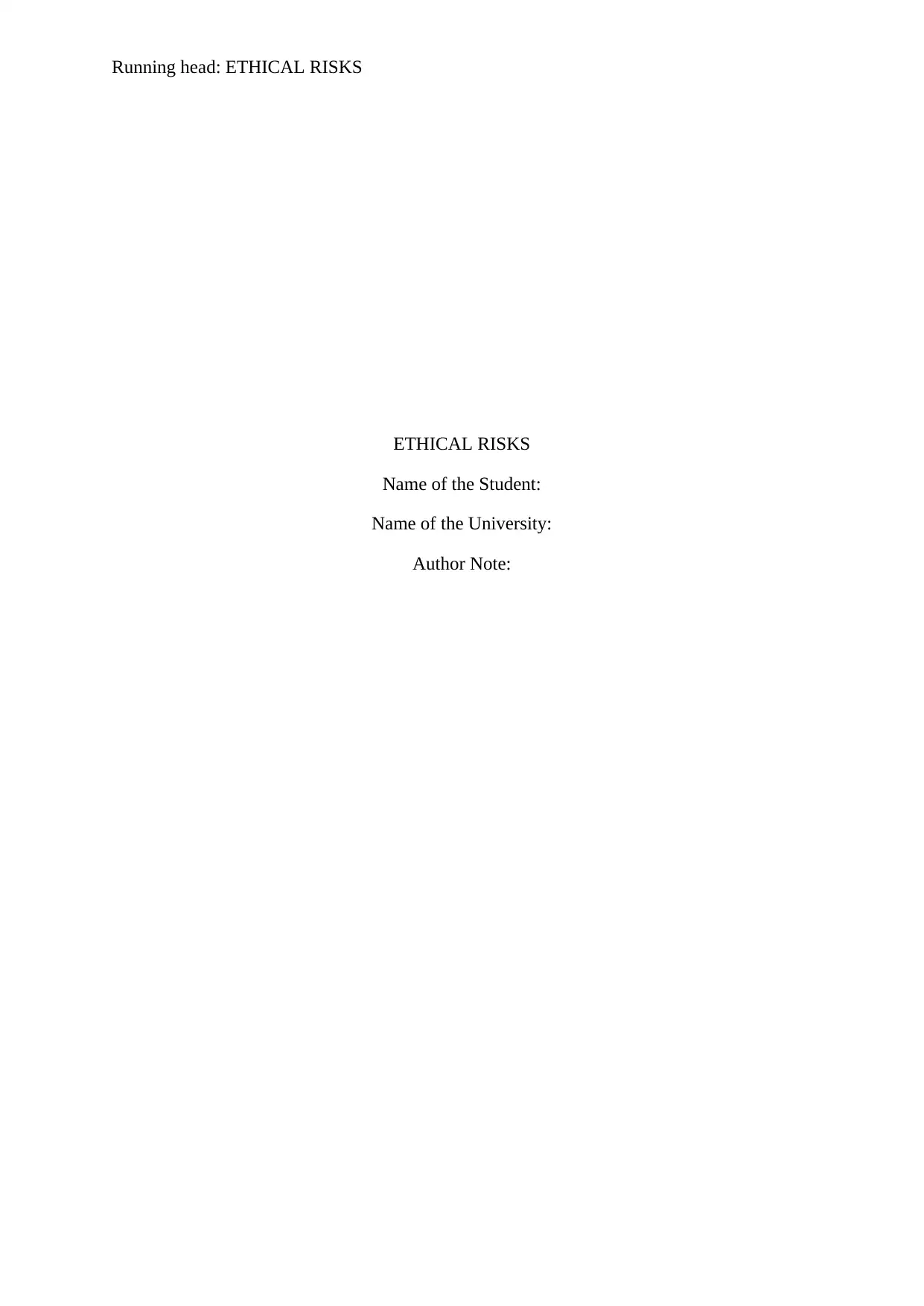
Running head: ETHICAL RISKS
ETHICAL RISKS
Name of the Student:
Name of the University:
Author Note:
ETHICAL RISKS
Name of the Student:
Name of the University:
Author Note:
Paraphrase This Document
Need a fresh take? Get an instant paraphrase of this document with our AI Paraphraser
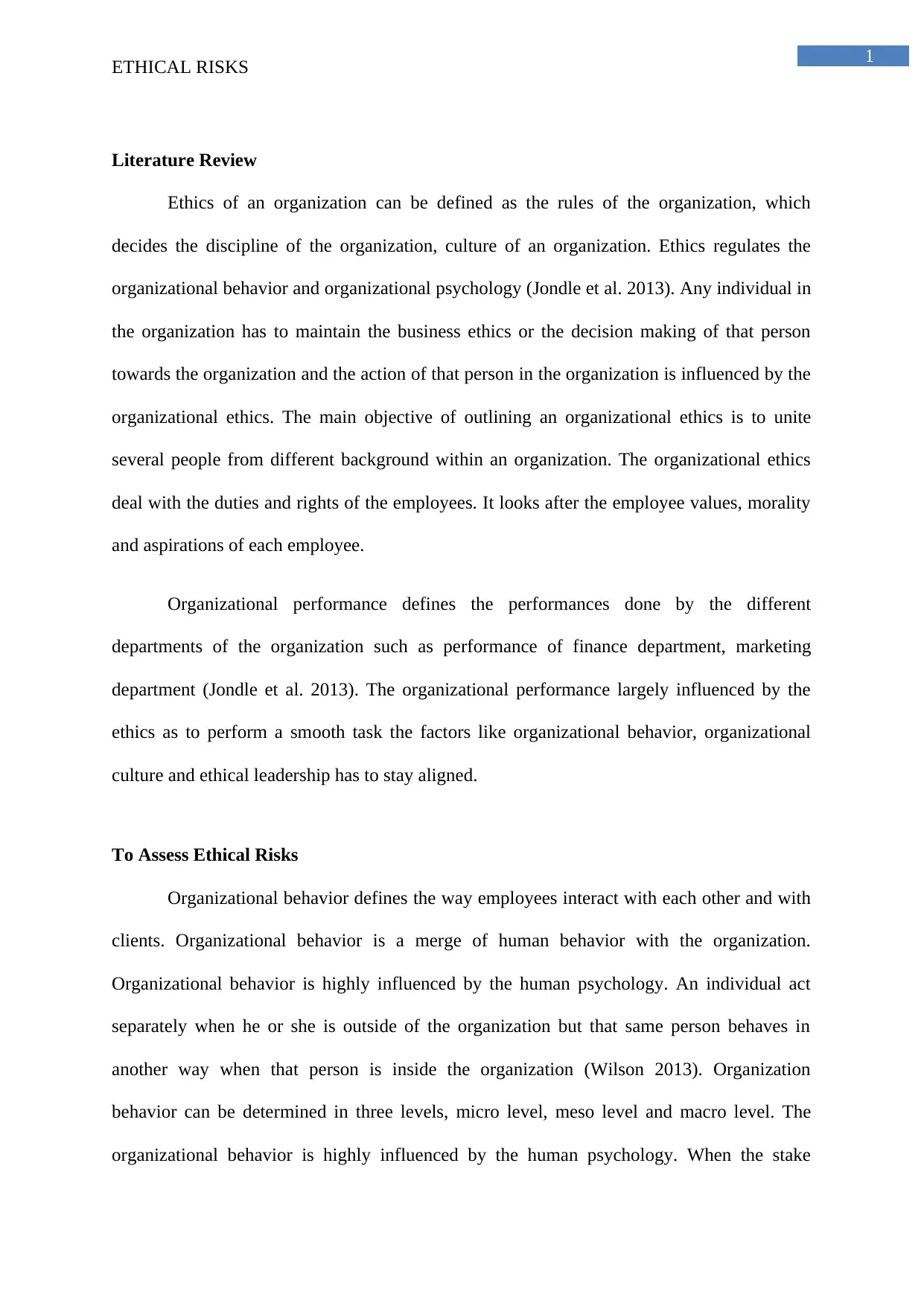
1
ETHICAL RISKS
Literature Review
Ethics of an organization can be defined as the rules of the organization, which
decides the discipline of the organization, culture of an organization. Ethics regulates the
organizational behavior and organizational psychology (Jondle et al. 2013). Any individual in
the organization has to maintain the business ethics or the decision making of that person
towards the organization and the action of that person in the organization is influenced by the
organizational ethics. The main objective of outlining an organizational ethics is to unite
several people from different background within an organization. The organizational ethics
deal with the duties and rights of the employees. It looks after the employee values, morality
and aspirations of each employee.
Organizational performance defines the performances done by the different
departments of the organization such as performance of finance department, marketing
department (Jondle et al. 2013). The organizational performance largely influenced by the
ethics as to perform a smooth task the factors like organizational behavior, organizational
culture and ethical leadership has to stay aligned.
To Assess Ethical Risks
Organizational behavior defines the way employees interact with each other and with
clients. Organizational behavior is a merge of human behavior with the organization.
Organizational behavior is highly influenced by the human psychology. An individual act
separately when he or she is outside of the organization but that same person behaves in
another way when that person is inside the organization (Wilson 2013). Organization
behavior can be determined in three levels, micro level, meso level and macro level. The
organizational behavior is highly influenced by the human psychology. When the stake
ETHICAL RISKS
Literature Review
Ethics of an organization can be defined as the rules of the organization, which
decides the discipline of the organization, culture of an organization. Ethics regulates the
organizational behavior and organizational psychology (Jondle et al. 2013). Any individual in
the organization has to maintain the business ethics or the decision making of that person
towards the organization and the action of that person in the organization is influenced by the
organizational ethics. The main objective of outlining an organizational ethics is to unite
several people from different background within an organization. The organizational ethics
deal with the duties and rights of the employees. It looks after the employee values, morality
and aspirations of each employee.
Organizational performance defines the performances done by the different
departments of the organization such as performance of finance department, marketing
department (Jondle et al. 2013). The organizational performance largely influenced by the
ethics as to perform a smooth task the factors like organizational behavior, organizational
culture and ethical leadership has to stay aligned.
To Assess Ethical Risks
Organizational behavior defines the way employees interact with each other and with
clients. Organizational behavior is a merge of human behavior with the organization.
Organizational behavior is highly influenced by the human psychology. An individual act
separately when he or she is outside of the organization but that same person behaves in
another way when that person is inside the organization (Wilson 2013). Organization
behavior can be determined in three levels, micro level, meso level and macro level. The
organizational behavior is highly influenced by the human psychology. When the stake
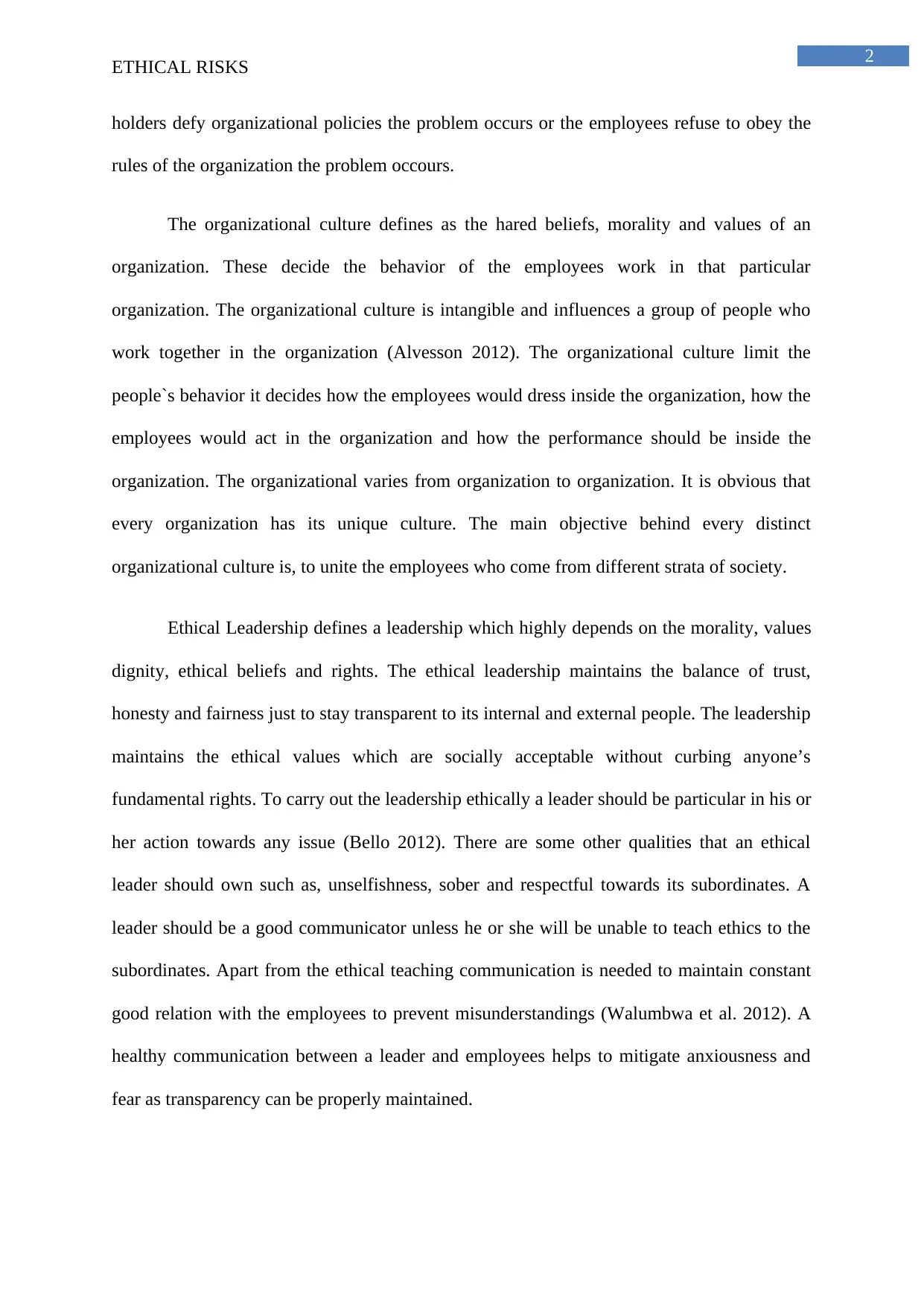
2
ETHICAL RISKS
holders defy organizational policies the problem occurs or the employees refuse to obey the
rules of the organization the problem occours.
The organizational culture defines as the hared beliefs, morality and values of an
organization. These decide the behavior of the employees work in that particular
organization. The organizational culture is intangible and influences a group of people who
work together in the organization (Alvesson 2012). The organizational culture limit the
people`s behavior it decides how the employees would dress inside the organization, how the
employees would act in the organization and how the performance should be inside the
organization. The organizational varies from organization to organization. It is obvious that
every organization has its unique culture. The main objective behind every distinct
organizational culture is, to unite the employees who come from different strata of society.
Ethical Leadership defines a leadership which highly depends on the morality, values
dignity, ethical beliefs and rights. The ethical leadership maintains the balance of trust,
honesty and fairness just to stay transparent to its internal and external people. The leadership
maintains the ethical values which are socially acceptable without curbing anyone’s
fundamental rights. To carry out the leadership ethically a leader should be particular in his or
her action towards any issue (Bello 2012). There are some other qualities that an ethical
leader should own such as, unselfishness, sober and respectful towards its subordinates. A
leader should be a good communicator unless he or she will be unable to teach ethics to the
subordinates. Apart from the ethical teaching communication is needed to maintain constant
good relation with the employees to prevent misunderstandings (Walumbwa et al. 2012). A
healthy communication between a leader and employees helps to mitigate anxiousness and
fear as transparency can be properly maintained.
ETHICAL RISKS
holders defy organizational policies the problem occurs or the employees refuse to obey the
rules of the organization the problem occours.
The organizational culture defines as the hared beliefs, morality and values of an
organization. These decide the behavior of the employees work in that particular
organization. The organizational culture is intangible and influences a group of people who
work together in the organization (Alvesson 2012). The organizational culture limit the
people`s behavior it decides how the employees would dress inside the organization, how the
employees would act in the organization and how the performance should be inside the
organization. The organizational varies from organization to organization. It is obvious that
every organization has its unique culture. The main objective behind every distinct
organizational culture is, to unite the employees who come from different strata of society.
Ethical Leadership defines a leadership which highly depends on the morality, values
dignity, ethical beliefs and rights. The ethical leadership maintains the balance of trust,
honesty and fairness just to stay transparent to its internal and external people. The leadership
maintains the ethical values which are socially acceptable without curbing anyone’s
fundamental rights. To carry out the leadership ethically a leader should be particular in his or
her action towards any issue (Bello 2012). There are some other qualities that an ethical
leader should own such as, unselfishness, sober and respectful towards its subordinates. A
leader should be a good communicator unless he or she will be unable to teach ethics to the
subordinates. Apart from the ethical teaching communication is needed to maintain constant
good relation with the employees to prevent misunderstandings (Walumbwa et al. 2012). A
healthy communication between a leader and employees helps to mitigate anxiousness and
fear as transparency can be properly maintained.
⊘ This is a preview!⊘
Do you want full access?
Subscribe today to unlock all pages.

Trusted by 1+ million students worldwide
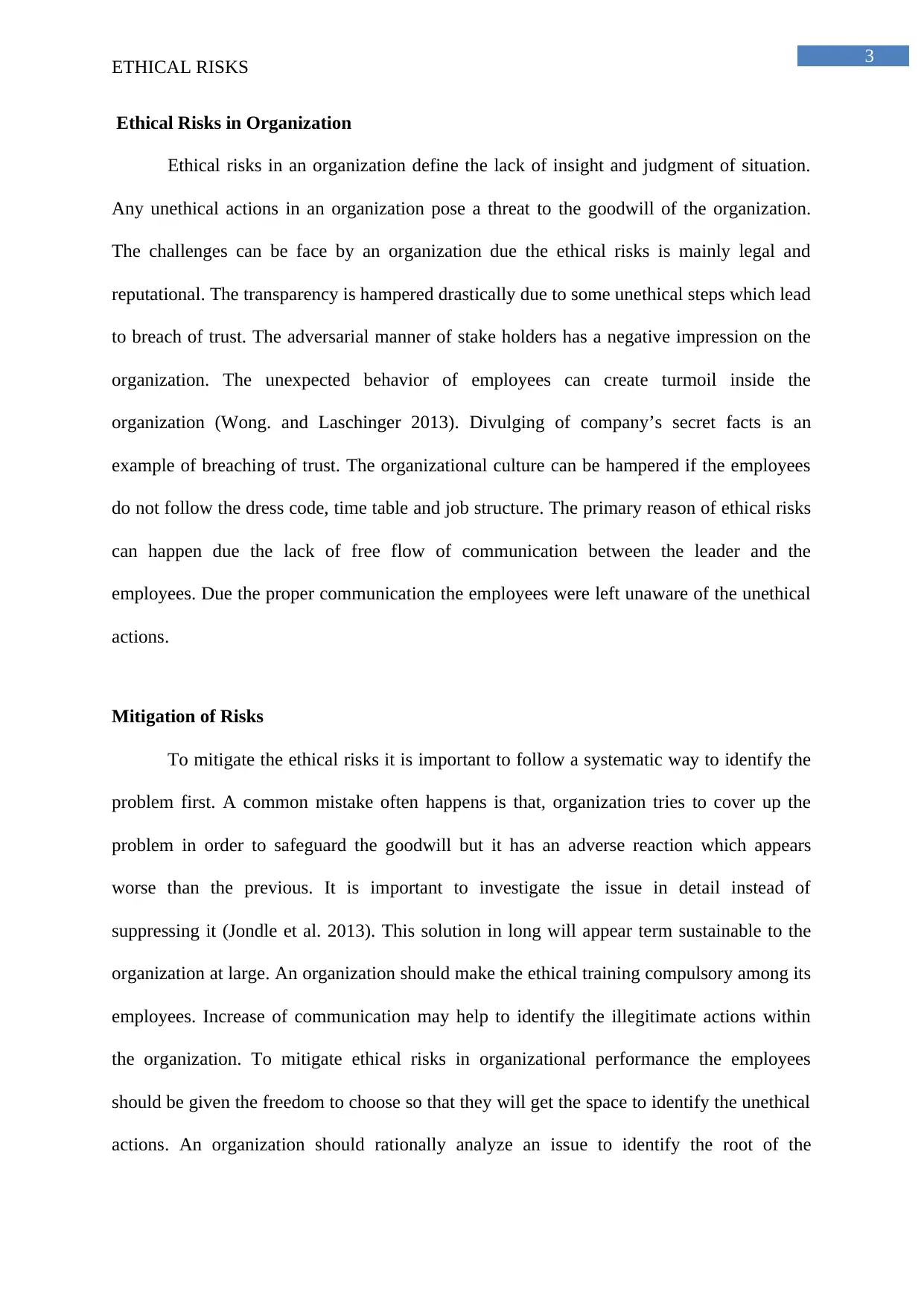
3
ETHICAL RISKS
Ethical Risks in Organization
Ethical risks in an organization define the lack of insight and judgment of situation.
Any unethical actions in an organization pose a threat to the goodwill of the organization.
The challenges can be face by an organization due the ethical risks is mainly legal and
reputational. The transparency is hampered drastically due to some unethical steps which lead
to breach of trust. The adversarial manner of stake holders has a negative impression on the
organization. The unexpected behavior of employees can create turmoil inside the
organization (Wong. and Laschinger 2013). Divulging of company’s secret facts is an
example of breaching of trust. The organizational culture can be hampered if the employees
do not follow the dress code, time table and job structure. The primary reason of ethical risks
can happen due the lack of free flow of communication between the leader and the
employees. Due the proper communication the employees were left unaware of the unethical
actions.
Mitigation of Risks
To mitigate the ethical risks it is important to follow a systematic way to identify the
problem first. A common mistake often happens is that, organization tries to cover up the
problem in order to safeguard the goodwill but it has an adverse reaction which appears
worse than the previous. It is important to investigate the issue in detail instead of
suppressing it (Jondle et al. 2013). This solution in long will appear term sustainable to the
organization at large. An organization should make the ethical training compulsory among its
employees. Increase of communication may help to identify the illegitimate actions within
the organization. To mitigate ethical risks in organizational performance the employees
should be given the freedom to choose so that they will get the space to identify the unethical
actions. An organization should rationally analyze an issue to identify the root of the
ETHICAL RISKS
Ethical Risks in Organization
Ethical risks in an organization define the lack of insight and judgment of situation.
Any unethical actions in an organization pose a threat to the goodwill of the organization.
The challenges can be face by an organization due the ethical risks is mainly legal and
reputational. The transparency is hampered drastically due to some unethical steps which lead
to breach of trust. The adversarial manner of stake holders has a negative impression on the
organization. The unexpected behavior of employees can create turmoil inside the
organization (Wong. and Laschinger 2013). Divulging of company’s secret facts is an
example of breaching of trust. The organizational culture can be hampered if the employees
do not follow the dress code, time table and job structure. The primary reason of ethical risks
can happen due the lack of free flow of communication between the leader and the
employees. Due the proper communication the employees were left unaware of the unethical
actions.
Mitigation of Risks
To mitigate the ethical risks it is important to follow a systematic way to identify the
problem first. A common mistake often happens is that, organization tries to cover up the
problem in order to safeguard the goodwill but it has an adverse reaction which appears
worse than the previous. It is important to investigate the issue in detail instead of
suppressing it (Jondle et al. 2013). This solution in long will appear term sustainable to the
organization at large. An organization should make the ethical training compulsory among its
employees. Increase of communication may help to identify the illegitimate actions within
the organization. To mitigate ethical risks in organizational performance the employees
should be given the freedom to choose so that they will get the space to identify the unethical
actions. An organization should rationally analyze an issue to identify the root of the
Paraphrase This Document
Need a fresh take? Get an instant paraphrase of this document with our AI Paraphraser
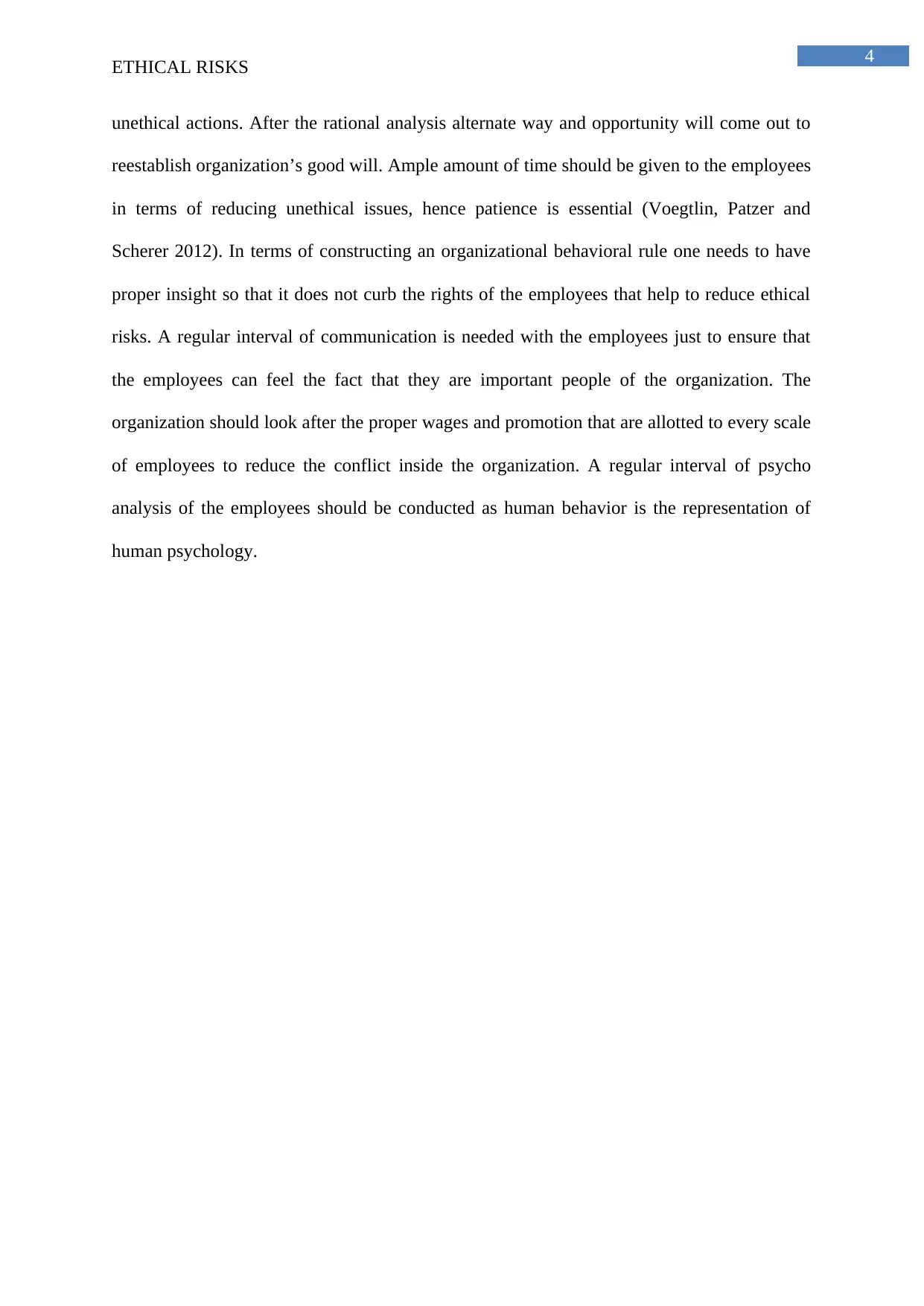
4
ETHICAL RISKS
unethical actions. After the rational analysis alternate way and opportunity will come out to
reestablish organization’s good will. Ample amount of time should be given to the employees
in terms of reducing unethical issues, hence patience is essential (Voegtlin, Patzer and
Scherer 2012). In terms of constructing an organizational behavioral rule one needs to have
proper insight so that it does not curb the rights of the employees that help to reduce ethical
risks. A regular interval of communication is needed with the employees just to ensure that
the employees can feel the fact that they are important people of the organization. The
organization should look after the proper wages and promotion that are allotted to every scale
of employees to reduce the conflict inside the organization. A regular interval of psycho
analysis of the employees should be conducted as human behavior is the representation of
human psychology.
ETHICAL RISKS
unethical actions. After the rational analysis alternate way and opportunity will come out to
reestablish organization’s good will. Ample amount of time should be given to the employees
in terms of reducing unethical issues, hence patience is essential (Voegtlin, Patzer and
Scherer 2012). In terms of constructing an organizational behavioral rule one needs to have
proper insight so that it does not curb the rights of the employees that help to reduce ethical
risks. A regular interval of communication is needed with the employees just to ensure that
the employees can feel the fact that they are important people of the organization. The
organization should look after the proper wages and promotion that are allotted to every scale
of employees to reduce the conflict inside the organization. A regular interval of psycho
analysis of the employees should be conducted as human behavior is the representation of
human psychology.
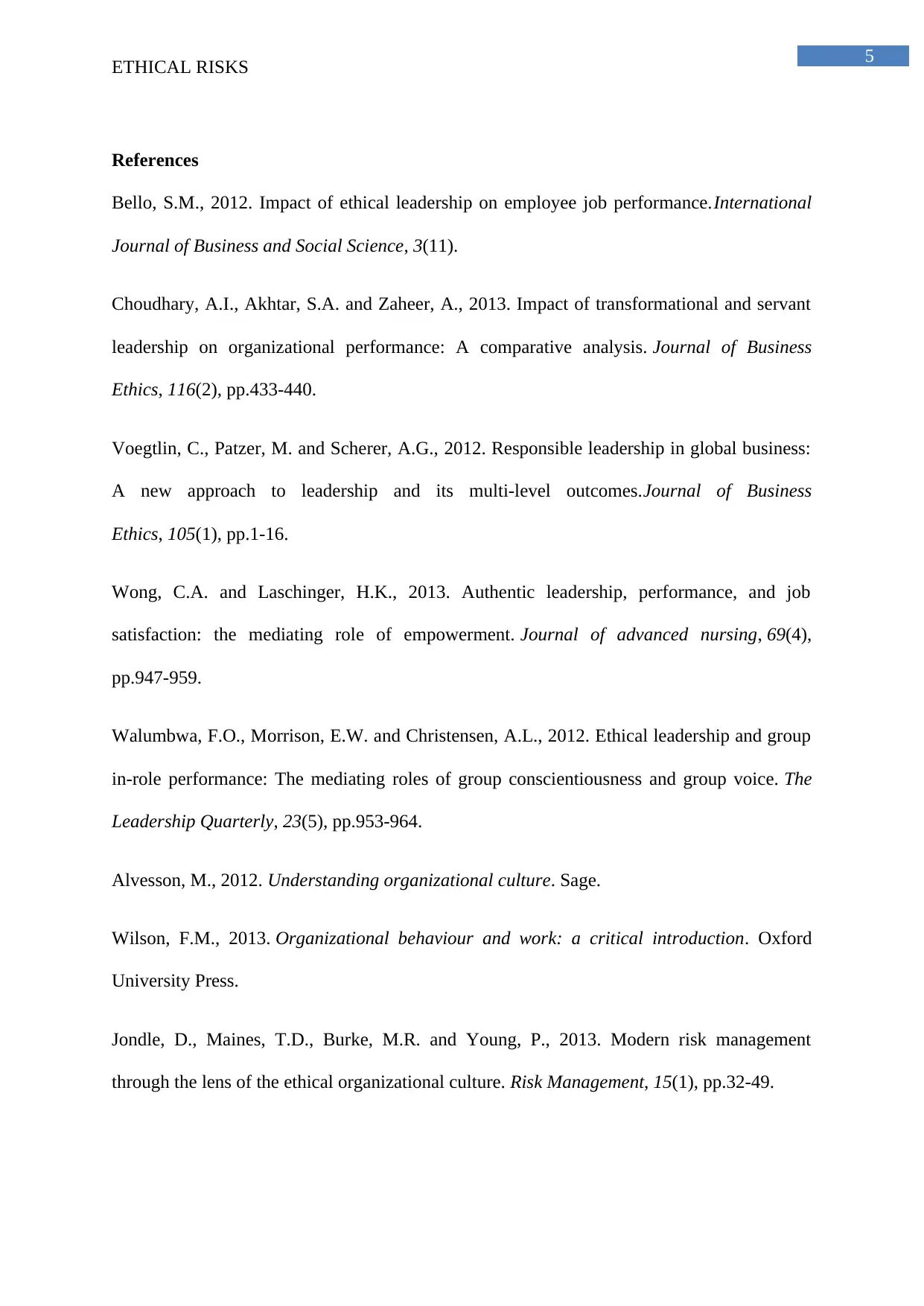
5
ETHICAL RISKS
References
Bello, S.M., 2012. Impact of ethical leadership on employee job performance.International
Journal of Business and Social Science, 3(11).
Choudhary, A.I., Akhtar, S.A. and Zaheer, A., 2013. Impact of transformational and servant
leadership on organizational performance: A comparative analysis. Journal of Business
Ethics, 116(2), pp.433-440.
Voegtlin, C., Patzer, M. and Scherer, A.G., 2012. Responsible leadership in global business:
A new approach to leadership and its multi-level outcomes.Journal of Business
Ethics, 105(1), pp.1-16.
Wong, C.A. and Laschinger, H.K., 2013. Authentic leadership, performance, and job
satisfaction: the mediating role of empowerment. Journal of advanced nursing, 69(4),
pp.947-959.
Walumbwa, F.O., Morrison, E.W. and Christensen, A.L., 2012. Ethical leadership and group
in-role performance: The mediating roles of group conscientiousness and group voice. The
Leadership Quarterly, 23(5), pp.953-964.
Alvesson, M., 2012. Understanding organizational culture. Sage.
Wilson, F.M., 2013. Organizational behaviour and work: a critical introduction. Oxford
University Press.
Jondle, D., Maines, T.D., Burke, M.R. and Young, P., 2013. Modern risk management
through the lens of the ethical organizational culture. Risk Management, 15(1), pp.32-49.
ETHICAL RISKS
References
Bello, S.M., 2012. Impact of ethical leadership on employee job performance.International
Journal of Business and Social Science, 3(11).
Choudhary, A.I., Akhtar, S.A. and Zaheer, A., 2013. Impact of transformational and servant
leadership on organizational performance: A comparative analysis. Journal of Business
Ethics, 116(2), pp.433-440.
Voegtlin, C., Patzer, M. and Scherer, A.G., 2012. Responsible leadership in global business:
A new approach to leadership and its multi-level outcomes.Journal of Business
Ethics, 105(1), pp.1-16.
Wong, C.A. and Laschinger, H.K., 2013. Authentic leadership, performance, and job
satisfaction: the mediating role of empowerment. Journal of advanced nursing, 69(4),
pp.947-959.
Walumbwa, F.O., Morrison, E.W. and Christensen, A.L., 2012. Ethical leadership and group
in-role performance: The mediating roles of group conscientiousness and group voice. The
Leadership Quarterly, 23(5), pp.953-964.
Alvesson, M., 2012. Understanding organizational culture. Sage.
Wilson, F.M., 2013. Organizational behaviour and work: a critical introduction. Oxford
University Press.
Jondle, D., Maines, T.D., Burke, M.R. and Young, P., 2013. Modern risk management
through the lens of the ethical organizational culture. Risk Management, 15(1), pp.32-49.
⊘ This is a preview!⊘
Do you want full access?
Subscribe today to unlock all pages.

Trusted by 1+ million students worldwide

6
ETHICAL RISKS
ETHICAL RISKS
1 out of 7
Related Documents
Your All-in-One AI-Powered Toolkit for Academic Success.
+13062052269
info@desklib.com
Available 24*7 on WhatsApp / Email
![[object Object]](/_next/static/media/star-bottom.7253800d.svg)
Unlock your academic potential
Copyright © 2020–2025 A2Z Services. All Rights Reserved. Developed and managed by ZUCOL.





